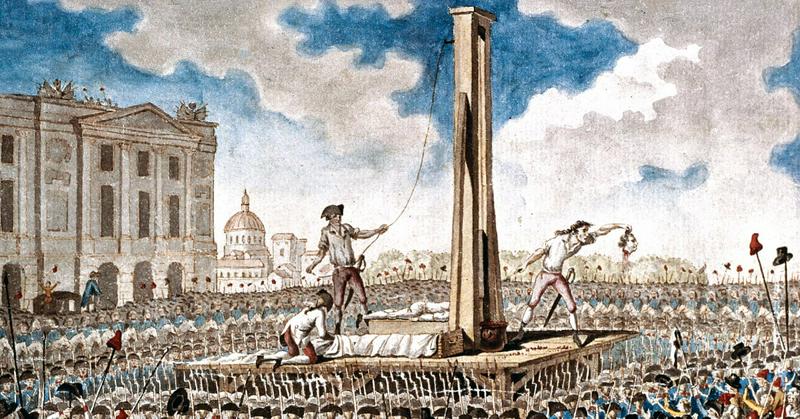Guillotine: History Of The French Invention That Made Death Into Theater
By | April 23, 2020

Today marks the 228th anniversary of the guillotine, which sliced its way onto the capital punishment scene on April 25, 1792 with the execution of French criminal Nicolas Jacques Pelletier. The deadly apparatus was originally devised a few years earlier by a doctor, surprisingly enough, by the name of Joseph-Ignace Guillotin. Although it sounds counterintuitive, Guillotin actually invented the murder machine to offer a more humane form of death to those sentenced, and it's hard to say he didn't succeed. At the time, the method of choice was drawing and quartering, in which the condemned is hanged, dragging by a horse, disemboweled, and dismembered. The swift chop of the guillotine is a paper cut in comparison.
With a heavy blade and straps to keep the victim still, the guillotine was also much more effective and dependable than the typical beheading by sword since it didn’t rely either strength or aim to behead the unfortunate prisoner. Unlike hanging, death by guillotine was thought to be both immediate (at least, as immediate as possible—more on that shortly) and painless.

The guillotine couldn't have come at a better (or worse, depending on your perspective) time. It coincided with the French Revolution, so idealist revolutionaries were already pretty psyched to punish the nobles who had starved and oppressed them for centuries. On January 21, 1793, King Louis XVI of France was executed by guillotine, and his wife, Queen Marie Antoinette, would suffer the same fate just nine months later. Many nobles were soon to follow.
Originally, the guillotine stood for some level of equality, as all classes died the same way. However, what may have once been the vigor of revolutionary spirit quickly devolved into bloodlust. The theatrical flair of the guillotine drew huge crowds, and justice became entertainment. Children even began making tiny guillotine toys.
The vengeful fever that had swept France suited fundamentalist revolutionaries like Maximilien Robespierre, who took power in the chaos. Robespierre was a strict moralist with a fanatical commitment to the core ideals of the Revolution, but while many people initially looked up to him as a man of strength, they would soon regret his rise to power. In 1793, Robespierre—alongside the ironically named Committee of Public Safety—ushered in a Reign of Terror that would see over 40,000 citizens die in just one year. Over 16,000 of the Terror's casualties were formally executed by guillotine.

One notable case was that of Charlotte Corday, who was convicted of murdering a revolutionary Jacobin by stabbing him as he bathed. It was customary for the executioner to lift the head of the deceased for the audience after the deed was done, but Corday's executioner got caught up in the moment and slapped her face for good measure. According to many witnesses, she appeared to react.
It might not be a tall tale. Since it takes the brain a few seconds to experience cell death, it's not uncommon for the faces of decapitated people to move in the moments following death. Since we can't exactly ask the only people who have experienced it, it's not known for sure if humans actually retain consciousness in the seconds after decapitation or if the eerie movement is simply some kind of involuntary twitch. It may have simply been a gruesome coincidence, or Corday may have been truly offended.

Eventually, the people of France started to wonder if perhaps this whole Reign of Terror thing had gone too far. Robespierre seemed to like chopping off people's heads a bit too much, so naturally, they chopped off his head before eventually putting an end to the Revolution.
As the thirst for blood subsided and order returned, those mourning their lost loved ones grieved in some pretty strange ways. One oddity of post-Revolution France was the rise of the so-called "victim's ball," a guillotine-themed party thrown by the families of the executed. They wore red, the color of the convicted, and tied red ribbons or wore red necklaces around their throats like a wound. Guests would even greet one another by "jerking their heads sharply downwards to imitate the moment of decapitation." Others went so far as to get their hair cut short—unpopular for the time—to mimic the look of someone whose hair had been chopped off during decapitation.
The guillotine's ugly work wasn't done after the Revolution, however. During WWII, the Nazis actually matched fairly evenly with France, killing over 16,000 people by guillotine. France's final public execution took place in 1939, when serial killer Eugen Weiddman shuffled off this mortal coil in front of a crowd of a few hundred. That doesn't mean the guillotine went out with the '30s. The nation actually used the gruesome method of capital punishment all the way until the 1970s, albeit privately. After Hamida Djandoubi was convicted of the violent assault and murder of a young woman, he earned the dishonor of experiencing the final whack in 1977. Within five years of this disco-era decapitation, France outlawed the death penalty altogether. Today, the guillotine mostly lives on in historical dramas and threats against Jeff Bezos.

